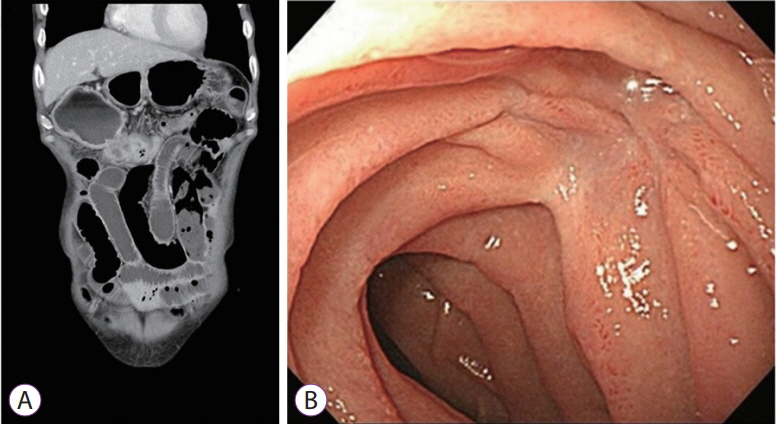Clin Endosc.
2019 Mar;52(2):191-195. 10.5946/ce.2018.088.
Is it Possible to Successfully Treat Locally Advanced Colon Cancer Using Pre-Operative Chemoradiotherapy?
- Affiliations
-
- 1Department of Internal Medicine, Kosin University College of Medicine, Busan, Korea. parksj6406@hanmail.net
- 2Department of Colorectal Surgery, Kosin University College of Medicine, Busan, Korea.
- 3Department of Radiology, Kosin University College of Medicine, Busan, Korea.
- KMID: 2447678
- DOI: http://doi.org/10.5946/ce.2018.088
Abstract
- Pre-operative chemoradiotherapy (CRT) is a preferable treatment option for patients with locally advanced rectal cancer. However, few data are available regarding pre-operative CRT for locally advanced colon cancer. Here, we describe two cases of successful treatment with pre-operative CRT and establish evidence supporting this treatment option in patients with locally advanced colon cancer. In the first case, a 65-year-old woman was diagnosed with ascending colon cancer with duodenal invasion. In the second case, a 63-year-old man was diagnosed with a colonic-duodenal fistula due to transverse colon cancer invasion. These case reports will help to establish a treatment consensus for pre-operative CRT in patients with locally advanced colon cancer.
Keyword
MeSH Terms
Figure
Reference
-
1. Bevan R, Rutter MD. Colorectal cancer screening-who, how, and when? Clin Endosc. 2018; 51:37–49.
Article2. Govindarajan A, Fraser N, Cranford V, et al. Predictors of multivisceral resection in patients with locally advanced colorectal cancer. Ann Surg Oncol. 2008; 15:1923–1930.
Article3. Staniunas RJ, Schoetz DJ Jr. Extended resection for carcinoma of colon and rectum. Surg Clin North Am. 1993; 73:117–129.
Article4. National Comprehensive Cancer Network. NCCN clinical practice guidelines in oncology: rectal cancer version 3. 2017 [Internet]. Fort Washington (PA): National Comprehensive Cancer Network;c2017. [cited 2017 Mar 13]. Available from: https://www.nccn.org/professionals/physician_gls/pdf/rectal.pdf.5. Sauer R, Becker H, Hohenberger W, et al. Preoperative versus postoperative chemoradiotherapy for rectal cancer. N Engl J Med. 2004; 351:1731–1740.
Article6. National Comprehensive Cancer Network. NCCN clinical practice guidelines in oncology: colon cancer version 2. 2017 [Internet]. Fort Washington (PA): National Comprehensive Cancer Network;c2017. [cited 2017 Mar 13]. Available from: https://www.nccn.org/professionals/physician_gls/pdf/colon.pdf.7. Sauer R, Liersch T, Merkel S, et al. Preoperative versus postoperative chemoradiotherapy for locally advanced rectal cancer: results of the German CAO/ARO/AIO-94 randomized phase III trial after a median follow-up of 11 years. J Clin Oncol. 2012; 30:1926–1933.
Article8. Khrizman P, Niland JC, ter Veer A, et al. Postoperative adjuvant chemotherapy use in patients with stage II/III rectal cancer treated with neoadjuvant therapy: a national comprehensive cancer network analysis. J Clin Oncol. 2013; 31:30–38.
Article9. Franke AJ, Parekh H, Starr JS, Tan SA, Iqbal A, George TJ Jr. Total neoadjuvant therapy: a shifting paradigm in locally advanced rectal cancer management. Clin Colorectal Cancer. 2018; 17:1–12.
Article10. Kalyan A, Rozelle S, Benson A 3rd. Neoadjuvant treatment of rectal cancer: where are we now? Gastroenterol Rep (Oxf). 2016; 4:206–209.
Article11. Agranovich A, Berthelet E. Radiotherapy for colorectal cancer. B C Med J. 2000; 42:139–141.12. Curley SA, Carlson GW, Shumate CR, Wishnow KI, Ames FC. Extended resection for locally advanced colorectal carcinoma. Am J Surg. 1992; 163:553–559.
Article13. Curley SA, Evans DB, Ames FC. Resection for cure of carcinoma of the colon directly invading the duodenum or pancreatic head. J Am Coll Surg. 1994; 179:587–592.14. Taylor WE, Donohue JH, Gunderson LL, et al. The Mayo Clinic experience with multimodality treatment of locally advanced or recurrent colon cancer. Ann Surg Oncol. 2002; 9:177–185.
Article
- Full Text Links
- Actions
-
Cited
- CITED
-
- Close
- Share
- Similar articles
-
- Long Term Complete Response of Unresectable Locally Advanced Pancreatic Cancer after CCRT and Gemcitabine Chemotherapy
- Preoperative Concurrent Chemoradiotherapy with Oral Fluoropyrimidine in Locally Advanced Rectal Cancer: How Good Is Good Enough?
- Does the Addition of Adjuvant Chemotherapy to Concurrent Chemoradiotherapy Improve the Survival of Patients with Locally Advanced Nasopharyngeal Cancer?
- Surgical issues in locally advanced rectal cancer treated by preoperative chemoradiotherapy
- The Effects and Surgical Morbidity of Preoperative Combined Chemoradiotherapy for Locally Advanced Rectal Cancer





